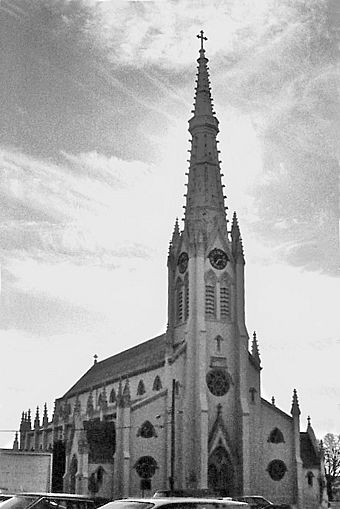Basilica of Saint Mary of the Immaculate Conception (Norfolk, Virginia) facts for kids
|
St. Mary's Church
|
|

St Mary's Church facade on Chapel Street, in downtown Norfolk
|
|
| Location | 232 Chapel St., Norfolk, Virginia |
|---|---|
| Area | 2 acres (0.81 ha) |
| Built | 1857-1858, 1894 |
| Architectural style | Late Gothic Revival, Gothic Revival |
| NRHP reference No. | 79003287 |
Quick facts for kids Significant dates |
|
| Added to NRHP | May 25, 1979 |
The Minor Basilica of Saint Mary of the Immaculate Conception is a very old and important church in downtown Norfolk, Virginia. It is also known as the Black Basilica because it has a strong connection to the African American community. This church is the oldest Catholic parish in the Diocese of Richmond. People in the area often call it "The Mother Church of Tidewater Virginia."
The church building was first built between 1857 and 1858. It is made of brick covered with stucco and has a tall tower with a spire in the middle. There is also a rectory, which is a three-story brick building where the priests live. Both buildings show the Gothic Revival style of architecture.
In 1979, the church was added to the National Register of Historic Places, which means it's a special historical site. Later, in 1991, it was given the special title of a minor basilica. The Saint Mary's Catholic Cemetery next to the church was also added to the list in 2001.
Contents
History of the Church
How It Started
The church began in 1791 as Saint Patrick Church. It was started by French Catholics who were escaping the French Revolution. Soon, some of the first Irish Catholic immigrants in the United States joined them. Saint Patrick's was the very first Catholic parish in the Richmond Diocese. It was even around 29 years before the diocese itself was officially formed!
The First Church Building
The first church building was finished in 1842. At that time, in the Southern United States, many churches kept people of different races separate. The first St. Patrick's Church was mainly for White people.
However, a priest named Father Matthew O’Keefe made a big change. He allowed African American Catholics to sit in a special part of the choir loft. Some groups who didn't like Catholics tried to stop him. They even tried to scare White church members. But Father O’Keefe got police help, and he kept the church open to everyone.
Sadly, the church building was destroyed by fire in 1856. Records from the diocese suggest that some local Catholic families believed the groups who opposed Catholics were responsible. A beautiful painting called "The Assumption," which was a gift from King Louis Philippe and Queen Amelie, was lost in the fire.
Rebuilding and New Beginnings
The church building you see today was finished in 1858. It was given a new name: the Blessed Virgin Mary of the Immaculate Conception. This new name honored a special teaching about Mary that was announced in 1854 by Pope Pius IX.
The church also supported St. Mary Academy, a school in the city. This school gave a Christian education to many children, even those who were not Catholic. The church also runs a soup kitchen and helps people in Norfolk who are poor or homeless.
Joining Parishes and Renovations
In 1961, another nearby Catholic church, Saint Joseph's, joined with Saint Mary's. Saint Joseph's had mostly African American members. After they joined, almost all the members of the combined church were African American.
The church was added to the National Register of Historic Places in 1979. After that, it went through a big renovation and restoration project. The church was rededicated on November 1, 1989, looking beautiful and new.
Becoming a Minor Basilica
On December 8, 1991, the church celebrated its 200th anniversary. On this special day, Pope John Paul II gave the Church of Saint Mary of the Immaculate Conception the title of a minor basilica. It is the only one in Virginia and one of the few with a mostly African American community.
The Pope said that the Black cultural heritage makes the Church stronger and more complete. He said, "The Church needs you, just as you need the Church, for you are a part of the Church and the church is part of you."
Even after the renovations in 1979, the building started to have problems. A 2015 inspection showed a lot of damage from rot and termites in the walls and roof. This led to a second big restoration project that cost about $6.7 million. This work was finished in December 2020.
During this project, workers found crypts (underground burial places) and tunnels under the church floor. Some people think these tunnels might have been part of the Underground Railroad, a secret network that helped enslaved people find freedom. The restoration also fixed the church's historic organ, which had not worked since 1981.
Influence on Other Churches
Father Matthew O'Keefe, who was the first pastor of the new St. Mary's in Norfolk, later moved to Maryland. He helped design a new church there, the Church of the Immaculate Conception in Towson. This church, finished in 1906, looks very similar to St. Mary's. It has a larger round window instead of a spire, thicker columns inside, and brownstone decorations. Father O'Keefe is buried under the altar of the church in Towson.
Gallery
See also
 In Spanish: Basílica de Santa María de la Inmaculada Concepción (Norfolk) para niños
In Spanish: Basílica de Santa María de la Inmaculada Concepción (Norfolk) para niños







